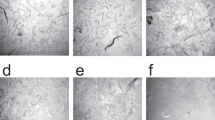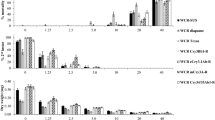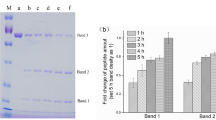Abstract
Field tests of corn co-expressing two new delta-endotoxins from Bacillus thuringiensis (Bt) have demonstrated protection from root damage by western corn rootworm (Diabrotica virgifera virgifera LeConte). The level of protection exceeds that provided by chemical insecticides. In the bacterium, these proteins form crystals during the sporulation phase of the growth cycle, are encoded by a single operon, and have molecular masses of 14 kDa and 44 kDa. Corn rootworm larvae fed on corn roots expressing the proteins showed histopathological symptoms in the midgut epithelium.
This is a preview of subscription content, access via your institution
Access options
Subscribe to this journal
Receive 12 print issues and online access
$209.00 per year
only $17.42 per issue
Buy this article
- Purchase on Springer Link
- Instant access to full article PDF
Prices may be subject to local taxes which are calculated during checkout



Similar content being viewed by others
Accession codes
References
Metcalf, R.L. In Methods for the study of the pest Diabrotica. (eds Krysan, J.L. & Miller, T.A.) vii–xv (Springer-Verlag, New York; 1986).
Levine, E. & Oloumi-Sadeghi, H. Western corn rootworm (Coleoptera: Chrysomelidae) larval injury to corn grown for seed production following soybeans grown for seed production. J. Econ. Entomol. 89, 1010–1016 (1996).
Schnepf, E. et al. Bacillus thuringiensis and its pesticidal crystal proteins. Microbiol. Mol. Biol. Rev. 62, 775–806 (1998).
Perlak, F.J. et al. Insect resistant cotton plants. Bio/Technology 8, 939–943 (1990).
Perlak, F.J. et al. Genetically improved potatoes: protection from damage by Colorado potato beetles. Plant Mol. Biol. 22, 313–321 (1993).
Fujimoto, H., Itoh, K., Yamamoto, M., Kyozuka, J. & Shimamoto, K. Insect resistant rice generated by introduction of a modified δ-endotoxin gene of Bacillus thuringiensis. Bio/Technology 11, 1151–1155 (1993).
Koziel M.G. et al. Field performance of elite transgenic maize plants expressing an insecticidal protein derived from Bacillus thuringiensis. Bio/Technology 11, 194–200 (1993).
Warren, G.W. Vegetative insecticidal proteins: novel proteins for control of corn pests. In Advances in insect control. (eds Carozzi, N. & Koziel, M.) 109–121 (Taylor and Francis, London, UK; 1997).
Estruch, J.J. et al. Vip3a, a novel Bacillus thuringiensis vegetative insecticidal protein with a wide spectrum of activities against lepidopteran insects. Proc. Natl. Acad. Sci. USA 93, 5389–5394 (1996).
Baumann, L., Broadwell, A.H. & Baumann, P. Sequence analysis of the mosquitocidal toxin genes encoding 51.4 and 41.9 kilodalton proteins from Bacillus sphaericus 2362 and 2297. J. Bacteriol. 170, 2045–2050 (1988).
Christensen, A.H., Sharrock, R.A. & Quail, P.H. Maize polyubiquitin genes: structure, thermal perturbation of expression and transcript splicing, and promoter activity following transfer to protoplasts by electroporation. Plant Mol. Biol. 18, 675–689 (1992).
Klein, T.M., Gradziel, T., Fromm, M.E. & Sanford, J.C. Factors influencing gene delivery into Zea mays cells by high velocity microprojectiles. Biotechnology 6, 559–563 (1989).
Ryerse, J.S., Purcell, J.P. & Sammoms, R.D. Structure and formation of the peritrophic membrane in the larva of the southern corn rootworm, Diabrotica undecimpunctata. Tissue Cell 26, 431–437 (1994).
Marrone, P., Ferri, F.D., Mosley, T.R. & Meinke, L.J. Improvements in laboratory rearing of the southern corn rootworm, Diabrotica undecimpunctata howardi Barber (Coleoptera: Chrysomelidae), on an artificial diet and corn. J. Econ. Entomol. 78, 290–293 (1985).
Armstrong, C.E. Development and availability of germplasm with high type II culture formation response. Maize Genet. Cooperative Newslett. 65, 92–93 (1991).
Chu, C.C. et al. Establishment of an efficient medium for anther culture of rice through comparative experiments on the nitrogen sources. Science Sinica 18, 659–668 (1975).
Murashige, T. & Skoog, F. A revised medium for rapid growth and bioassays with tobacco tissue cultures. Physiol. Plant 15, 473–497 (1962).
Hills, T.M. & Peters, D.C. A method of evaluating postplanting insecticide treatments for control of western corn rootworm larvae. J. Econ. Entomol. 64, 764–765 (1971).
Tukey, J.W. The problem of multiple comparisons. (Princeton University, Princeton. NJ; 1953).
Russell, R.M., Robertson, J.L. & Savin, N.E. POLO: a new computer program for Probit Analysis. ESA Bull. 23, 209–213 (1977).
Acknowledgements
We thank Theodore Kahn for helpful discussions and contributions to preparing figures and reviewing this manuscript. We thank Leo Kim, Dave Grothaus, Larry Sernyk, and Roger Kemble for their organizational leadership and helpful discussions. We thank Steve Ritchie for his contribution in corn breeding, and Clara Alarcon and David Hondred for Southern analysis. The authors also wish to acknowledge the excellent technical work of Josh Russell.
Author information
Authors and Affiliations
Corresponding author
Rights and permissions
About this article
Cite this article
Moellenbeck, D., Peters, M., Bing, J. et al. Insecticidal proteins from Bacillus thuringiensis protect corn from corn rootworms. Nat Biotechnol 19, 668–672 (2001). https://doi.org/10.1038/90282
Received:
Accepted:
Issue Date:
DOI: https://doi.org/10.1038/90282
This article is cited by
-
Crystal structure of RahU, an aegerolysin protein from the human pathogen Pseudomonas aeruginosa, and its interaction with membrane ceramide phosphorylethanolamine
Scientific Reports (2021)
-
Pore-forming protein complexes from Pleurotus mushrooms kill western corn rootworm and Colorado potato beetle through targeting membrane ceramide phosphoethanolamine
Scientific Reports (2019)
-
Generation of a selectable marker free, highly expressed single copy locus as landing pad for transgene stacking in sugarcane
Plant Molecular Biology (2019)
-
A soil bacterium can shape belowground interactions between maize, herbivores and entomopathogenic nematodes
Plant and Soil (2019)
-
Susceptible and mCry3A resistant corn rootworm larvae killed by a non-hemolytic Bacillus thuringiensis Cyt1Aa mutant
Scientific Reports (2018)



